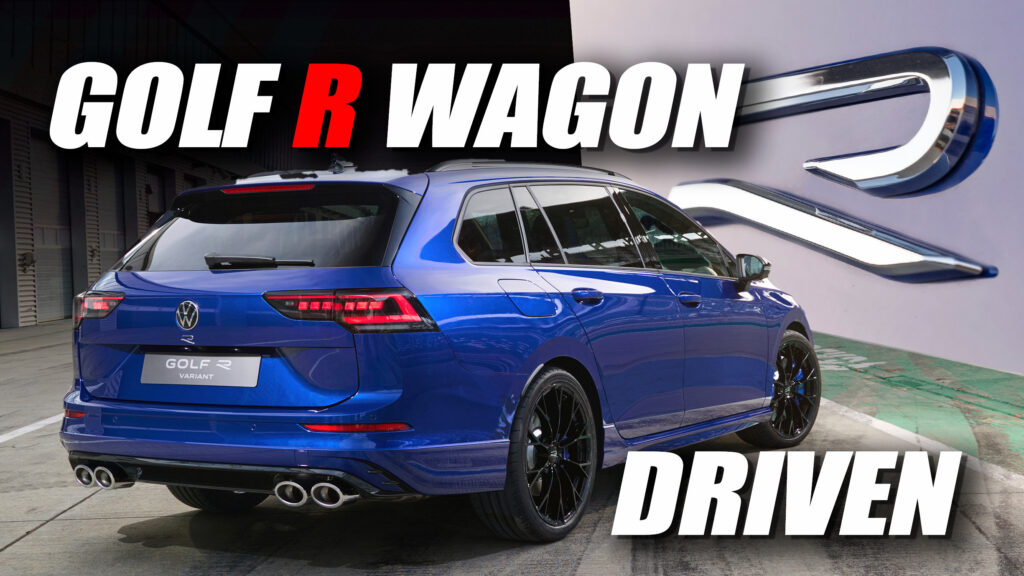The GTI’s near-50-year career means it’s still the most famous hot Golf, but it’s not the hottest for 2025. That role is taken once again by the Golf R, which grabs the GTI idea and expands it by adding more power and all-wheel drive. The 2025 R is the most muscular yet, and also the fastest.
But those aren’t the only reasons you might open your wallet a little further to step up from the newly-facelifted Mk8.5 GTI to an R. In the US both cars are only available in conventional hot hatch forms, but in Europe the R can be optioned as a wagon.
QUICK FACTS
Overview and what’s new
SUVs have been putting the squeeze on wagons for years now, but there’s an enclave of enthusiast drivers who’d still rather get their load-lugging kicks in a conventionally-shaped car with a big, square cargo area. Why? Because wagons weigh less and have a lower center of gravity than SUVs, and that usually leads to better handling and performance.
VW doesn’t offer the GTI as an estate, but its fancier R brother has been available as a wagon in Europe since 2015. And it’s back for 2025 as part of the facelifted Mk8.5 Golf lineup that brings subtle lighting tweaks, an illuminated VW grille badge, a horsepower boost and a much improved infotainment system. Unfortunately, the manual transmission option, which the UK dropped a while back, has also disappeared from other markets in the transition from Mk8 to Mk8.5, though maybe the stylish new 19-inch forged Warmenau wheels (a £1,120 option) will make up for it? Didn’t think so.
The R hatch costs £44,535 in the UK (US price TBC) and the R wagon will set you back £45,970 ($58,590), so no one will be snubbing the estate on cost grounds. There’s also a new R Black Edition, which brings dark-colored trim and wheels, is only available on the hatch, and costs £45,785 ($58,354).
Related: 2025 Volkswagen Golf R Is The Most Powerful Ever
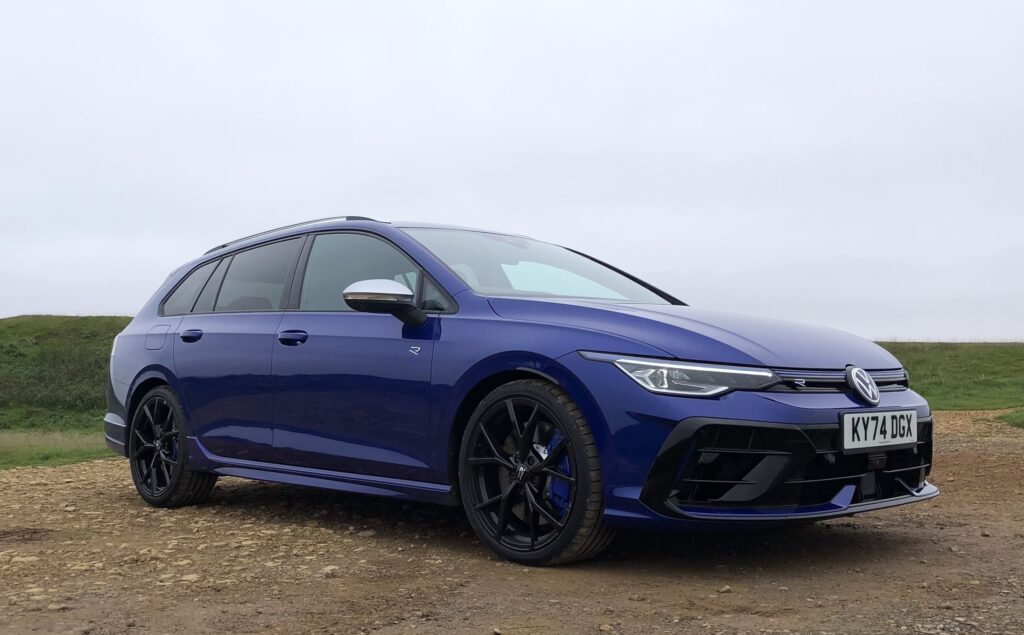
What’s under the hood?
We’ve touched on the bad news – the death of the R’s manual-shift option in the US – but there’s good under-hood news, too. The 2.0-liter, turbocharged four-cylinder engine now makes 328 hp (333 PS) in all markets, the same as the old European 333 limited edition, and 13 hp (14 PS) more than last year’s R.
You also get a solid 310 lb-ft (420 Nm) of torque, which scoots the R hatch to 62 mph (100 km/h) in 4.6 seconds and the slightly plumper wagon there in 4.8 – both figures a tenth quicker than before. Top speed is limited to 155 mph (250 km/h), though (Euro-spec) Black Edition cars have a 168 mph (270 km/h) limiter.
The 2025 GTI, in comparison, generates 261 hp (265 PS) in Europe and only 242 hp (245 PS) in America, meaning the R has a large power advantage. And an even bigger traction one. The Haldex all-wheel drive system operates in front-wheel drive most of the time, but can theoretically shuffle all of its torque to the rear wheels in extreme situations, and even has an optional drift mode.
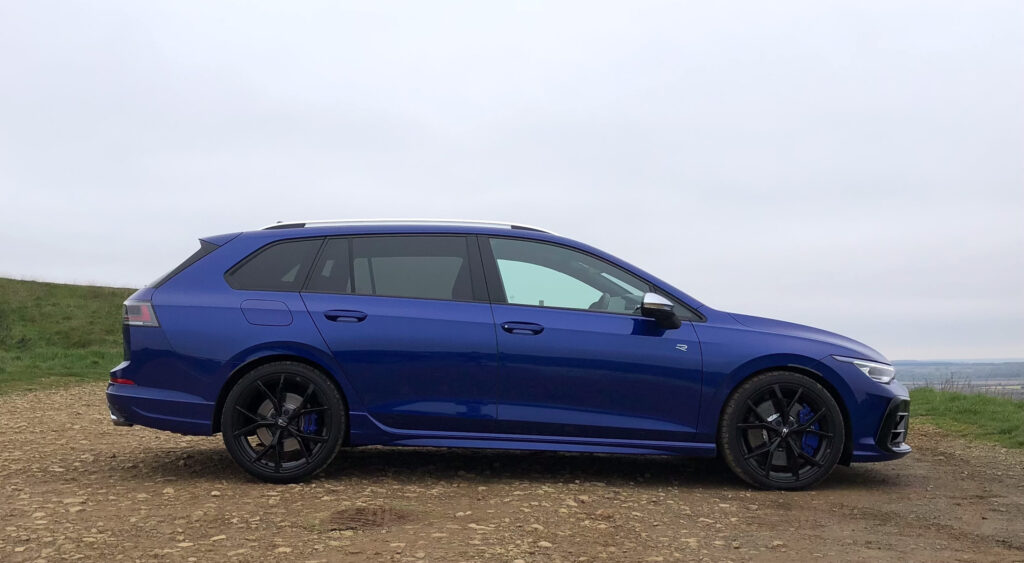
How does it drive?
We jumped into the Golf R wagon right after trying the new Euro-market 262 hp GTI hatch, and even accounting for the extra weight of the boxy back end and rear-drive hardware there was no mistaking the posher model’s extra grunt. Sure, some of the difference between the R’s 4.8-second 62 mph time and the 5.9 seconds the front-drive GTI needs to reach the same speed is accounted for by the way the all-wheel drive car digs in off the line, but the R also maintains an advantage at higher speeds.
It sounds better, too, and the retuned stock exhaust throws out some pops while an optional Akrapovic pipe unleashes a little extra roar. Hold the starter button for a beat longer when you go to fire it up and you’re also treated to flare of revs to 2,500 rpm. The hard-edged tone when revving out to the 6,500 rpm power peak compared with the GTI also suits the sense of urgency you get when you mash the right pedal. And that’s something you can do more often than you can in the GTI because you know the rear wheels can take some of the strain if the surface is damp.
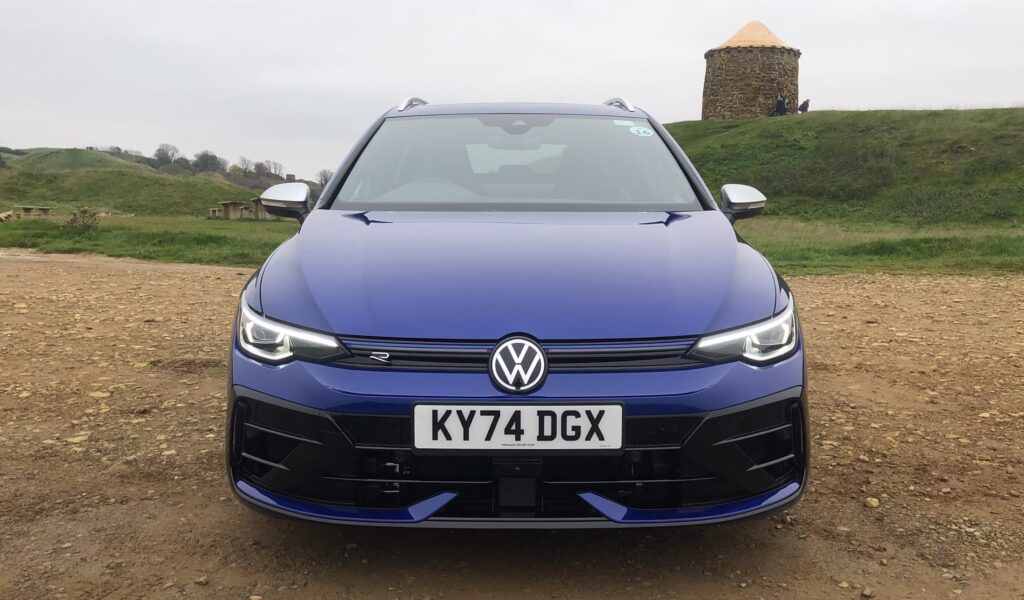
Unlike in the early days of the R, when the cars felt no more than front-wheel drive Golfs with some additional traction, the modern versions back up their front-end stick with the option to really let you lean on the rear tires through tighter corners, helped by the transmission’s ability to send 100 percent of torque to the outside rear wheel. That doesn’t only improve the turn-in – it even allows you to nudge the tail out on roundabouts and exiting intersections, while cars with the optional £1,960 Performance Pack (19 inch Estoril wheels, bigger spoiler, 168 mph limiter) add a dedicated Drift mode for parking lot mischief.
While not as outright thrilling a something like the latest Honda Civic Type R, the Golf R isn’t far behind in the dry, and its all-wheel drive system means it’ll be more capable in the wet and snow. We’ve got a couple of complaints though: the first is that DCC dampers are £735 option in the UK, when they should really be standard, and the second is that steering feel through the perforated leather rim could be better.
Photos Chris Chilton/Carscoops
How’s the interior?
If there was one area of the old R – and other Mk8 Golfs – that really wound people up, it was the interior. Not the driving position or the build quality or the other stuff that VW normally gets right, because that was still strong. No, it was the infotainment system and controls. The Mk8.5 is better, but not perfect.
The new 12.9-inch infotainment screen is a big improvement over the old one because it’s easier to see and reach, and the control interface is better and now includes ChatGPT voice activation. Another tech upgrade for 2025 is the revised 10.2-inch digital gauge cluster, which gains a G-meter and GPS lap timer.
VW has also seen sense and illuminated the temperature sliders below the screen, though we hope both (and the volume slider between them) are junked altogether in future in favor of some old fashioned rotary dials. It’s also a shame that the new R sticks with the MK8’s equally hated capacitive steering wheel buttons while the GTI gets to switch back to traditional physical buttons. Blame the R mode button on the wheel.
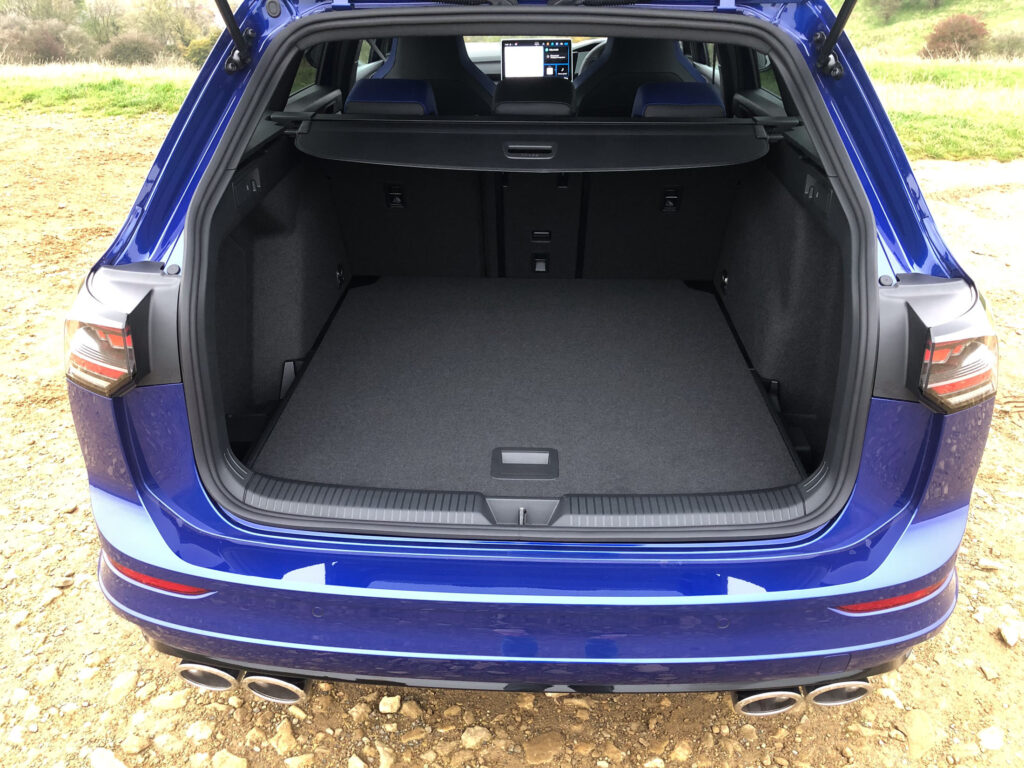
But if you can live with those issues, and we’re sure thousands of owners can, there’s plenty to like about the inside of the R wagon, which feels all but identical to the hatch from the rear seats forward. Rear room is okay, but not huge, and certainly not as good as on the Golf’s Skoda Octavia cousin, which rides on a 163 mm (6.4 inches) longer wheelbase. Behind those seats, though, is the R’s secret weapon, the trunk that turns this performance Golf from a handy second family runaround to the kind of car that can cover everything.
The load space is wide and deep and offers up 611 liters (21.58 cu-ft) of room with the seats up and 1,642 liters (58.0 cu-ft) with them folded. That dwarfs the 341/1,197 liters (12.0/42.3 cu-ft) you get in the R hatch and is better than the 540/1,600 liters (17.7/56.5 cu-ft) of room offered by BMW’s X1, which is one of the more spacious compact SUVs.
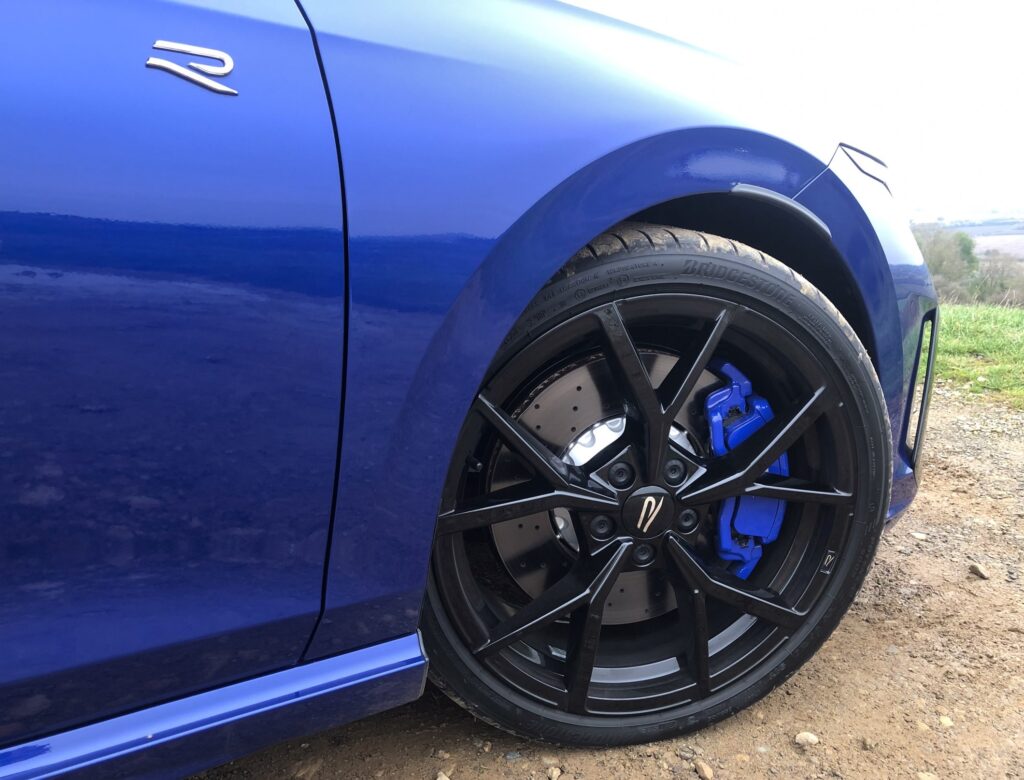
What are its rivals?
Fast wagons aren’t common, even in Europe, and many of those that are available, like the BMW M3 and M5 Touring and Audi’s RS6 Avant, cost 50 percent, and sometimes 100 percent, more than the Golf R. Even BMW’s M-lite M340i xDrive Touring will set you back an additional £17k ($21k), though that does net you a turbo’d six that gets it to 62 mph in 4.6 seconds – two tenths faster than the Golf.
But there are a couple of alternatives to the R that are similarly priced, and also rather familiar under the skin: the Cupra Leon Estate and Skoda Octavia vRS ride on the same MQB Evo VW Group platform. The Cupra even gets the R’s 328 hp, all-wheel drive powertrain, while the front-wheel drive, 261 hp Skoda runs the Golf GTI’s hardware, but offers more passenger and luggage space thanks to its longer wheelbase.
In the US, where you can’t buy either the Golf R or M340i in wagon guise and neither the Leon or Octavia is offered, the closest rivals are probably SUVs like the BMW X1 M35i xDrive and Mini Countryman JCW.
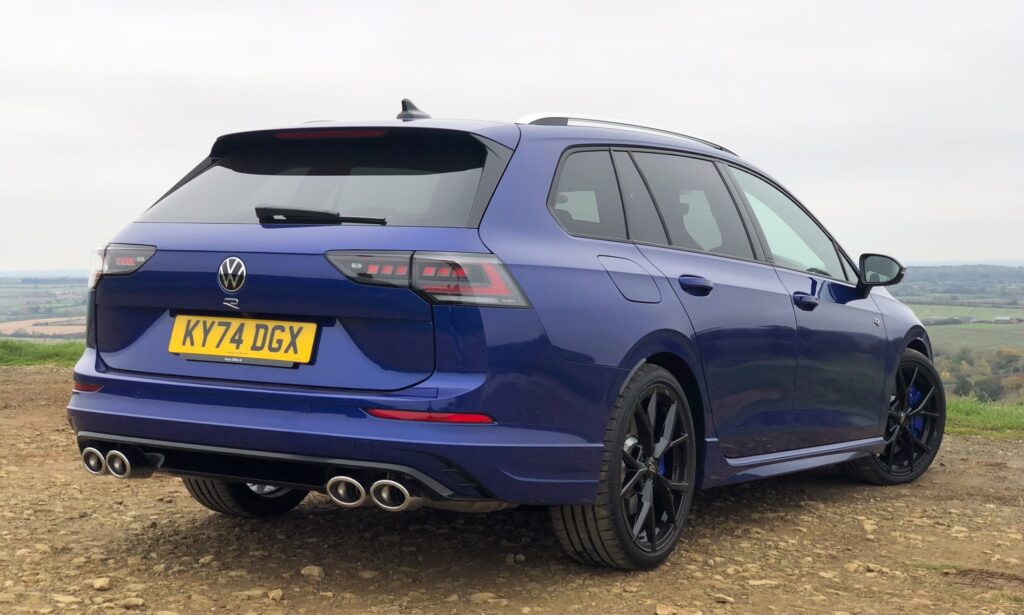
Verdict
Cars like the Golf R wagon are a niche proposition, but it’s great to see VW still thinks it’s a segment worth keeping alive, at least in some regions. In the configuration we tried the R feels only slightly slower and less lively than the hatch, while the small drop in performance is made up for by that generous cargo bay.
Throw in the all-wheel drive traction and you’ve got a car that’s as happy pounding around a track or persuading you to take the long way home as it is transporting a family of four and and all of their gear on a long trip. There aren’t many cars you can buy for vaguely sensible money with such a wide spread of talents, though features like the adaptive dampers really ought to be standard.
But those of you in countries that don’t get the R wagon needn’t feel too despondent, because all of the same Mk8.5 upgrades appear on the even faster hatch. You just need to remember to pack light.



